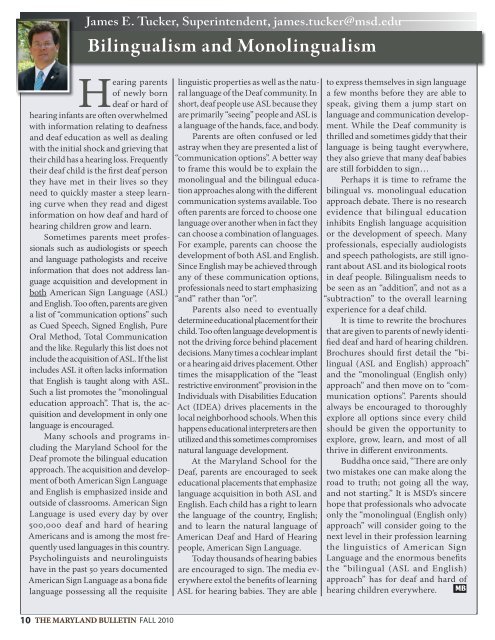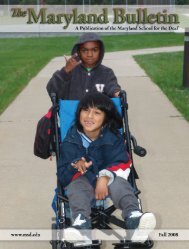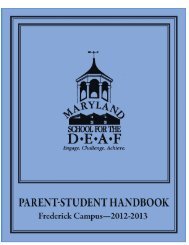Around MSD - Maryland School for the Deaf
Around MSD - Maryland School for the Deaf
Around MSD - Maryland School for the Deaf
You also want an ePaper? Increase the reach of your titles
YUMPU automatically turns print PDFs into web optimized ePapers that Google loves.
James E. Tucker, Superintendent, james.tucker@msd.edu<br />
Bilingualism and Monolingualism<br />
Hearing parents<br />
of newly born<br />
deaf or hard of<br />
hearing infants are often overwhelmed<br />
with in<strong>for</strong>mation relating to deafness<br />
and deaf education as well as dealing<br />
with <strong>the</strong> initial shock and grieving that<br />
<strong>the</strong>ir child has a hearing loss. Frequently<br />
<strong>the</strong>ir deaf child is <strong>the</strong> first deaf person<br />
<strong>the</strong>y have met in <strong>the</strong>ir lives so <strong>the</strong>y<br />
need to quickly master a steep learning<br />
curve when <strong>the</strong>y read and digest<br />
in<strong>for</strong>mation on how deaf and hard of<br />
hearing children grow and learn.<br />
Sometimes parents meet professionals<br />
such as audiologists or speech<br />
and language pathologists and receive<br />
in<strong>for</strong>mation that does not address language<br />
acquisition and development in<br />
both American Sign Language (ASL)<br />
and English. Too often, parents are given<br />
a list of “communication options” such<br />
as Cued Speech, Signed English, Pure<br />
Oral Method, Total Communication<br />
and <strong>the</strong> like. Regularly this list does not<br />
include <strong>the</strong> acquisition of ASL. If <strong>the</strong> list<br />
includes ASL it often lacks in<strong>for</strong>mation<br />
that English is taught along with ASL.<br />
Such a list promotes <strong>the</strong> “monolingual<br />
education approach”. That is, <strong>the</strong> acquisition<br />
and development in only one<br />
language is encouraged.<br />
Many schools and programs including<br />
<strong>the</strong> <strong>Maryland</strong> <strong>School</strong> <strong>for</strong> <strong>the</strong><br />
<strong>Deaf</strong> promote <strong>the</strong> bilingual education<br />
approach. The acquisition and development<br />
of both American Sign Language<br />
and English is emphasized inside and<br />
outside of classrooms. American Sign<br />
Language is used every day by over<br />
500,000 deaf and hard of hearing<br />
Americans and is among <strong>the</strong> most frequently<br />
used languages in this country.<br />
Psycholinguists and neurolinguists<br />
have in <strong>the</strong> past 50 years documented<br />
American Sign Language as a bona fide<br />
language possessing all <strong>the</strong> requisite<br />
10 THE MARYLAND BULLETIN FALL 2010<br />
linguistic properties as well as <strong>the</strong> natural<br />
language of <strong>the</strong> <strong>Deaf</strong> community. In<br />
short, deaf people use ASL because <strong>the</strong>y<br />
are primarily “seeing” people and ASL is<br />
a language of <strong>the</strong> hands, face, and body.<br />
Parents are often confused or led<br />
astray when <strong>the</strong>y are presented a list of<br />
“communication options”. A better way<br />
to frame this would be to explain <strong>the</strong><br />
monolingual and <strong>the</strong> bilingual education<br />
approaches along with <strong>the</strong> different<br />
communication systems available. Too<br />
often parents are <strong>for</strong>ced to choose one<br />
language over ano<strong>the</strong>r when in fact <strong>the</strong>y<br />
can choose a combination of languages.<br />
For example, parents can choose <strong>the</strong><br />
development of both ASL and English.<br />
Since English may be achieved through<br />
any of <strong>the</strong>se communication options,<br />
professionals need to start emphasizing<br />
“and” ra<strong>the</strong>r than “or”.<br />
Parents also need to eventually<br />
determine educational placement <strong>for</strong> <strong>the</strong>ir<br />
child. Too often language development is<br />
not <strong>the</strong> driving <strong>for</strong>ce behind placement<br />
decisions. Many times a cochlear implant<br />
or a hearing aid drives placement. O<strong>the</strong>r<br />
times <strong>the</strong> misapplication of <strong>the</strong> “least<br />
restrictive environment” provision in <strong>the</strong><br />
Individuals with Disabilities Education<br />
Act (IDEA) drives placements in <strong>the</strong><br />
local neighborhood schools. When this<br />
happens educational interpreters are <strong>the</strong>n<br />
utilized and this sometimes compromises<br />
natural language development.<br />
At <strong>the</strong> <strong>Maryland</strong> <strong>School</strong> <strong>for</strong> <strong>the</strong><br />
<strong>Deaf</strong>, parents are encouraged to seek<br />
educational placements that emphasize<br />
language acquisition in both ASL and<br />
English. Each child has a right to learn<br />
<strong>the</strong> language of <strong>the</strong> country, English;<br />
and to learn <strong>the</strong> natural language of<br />
American <strong>Deaf</strong> and Hard of Hearing<br />
people, American Sign Language.<br />
Today thousands of hearing babies<br />
are encouraged to sign. The media everywhere<br />
extol <strong>the</strong> benefits of learning<br />
ASL <strong>for</strong> hearing babies. They are able<br />
to express <strong>the</strong>mselves in sign language<br />
a few months be<strong>for</strong>e <strong>the</strong>y are able to<br />
speak, giving <strong>the</strong>m a jump start on<br />
language and communication development.<br />
While <strong>the</strong> <strong>Deaf</strong> community is<br />
thrilled and sometimes giddy that <strong>the</strong>ir<br />
language is being taught everywhere,<br />
<strong>the</strong>y also grieve that many deaf babies<br />
are still <strong>for</strong>bidden to sign…<br />
Perhaps it is time to reframe <strong>the</strong><br />
bilingual vs. monolingual education<br />
approach debate. There is no research<br />
evidence that bilingual education<br />
inhibits English language acquisition<br />
or <strong>the</strong> development of speech. Many<br />
professionals, especially audiologists<br />
and speech pathologists, are still ignorant<br />
about ASL and its biological roots<br />
in deaf people. Bilingualism needs to<br />
be seen as an “addition”, and not as a<br />
“subtraction” to <strong>the</strong> overall learning<br />
experience <strong>for</strong> a deaf child.<br />
It is time to rewrite <strong>the</strong> brochures<br />
that are given to parents of newly identified<br />
deaf and hard of hearing children.<br />
Brochures should first detail <strong>the</strong> “bilingual<br />
(ASL and English) approach”<br />
and <strong>the</strong> “monolingual (English only)<br />
approach” and <strong>the</strong>n move on to “communication<br />
options”. Parents should<br />
always be encouraged to thoroughly<br />
explore all options since every child<br />
should be given <strong>the</strong> opportunity to<br />
explore, grow, learn, and most of all<br />
thrive in different environments.<br />
Buddha once said, “There are only<br />
two mistakes one can make along <strong>the</strong><br />
road to truth; not going all <strong>the</strong> way,<br />
and not starting.” It is <strong>MSD</strong>’s sincere<br />
hope that professionals who advocate<br />
only <strong>the</strong> “monolingual (English only)<br />
approach” will consider going to <strong>the</strong><br />
next level in <strong>the</strong>ir profession learning<br />
<strong>the</strong> linguistics of American Sign<br />
Language and <strong>the</strong> enormous benefits<br />
<strong>the</strong> “bilingual (ASL and English)<br />
approach” has <strong>for</strong> deaf and hard of<br />
hearing children everywhere. MB






